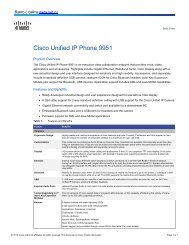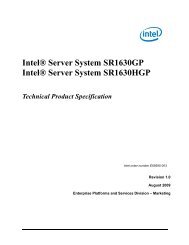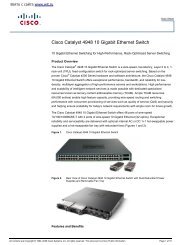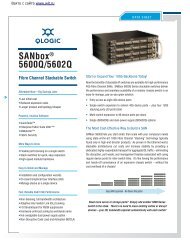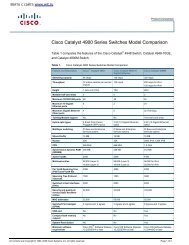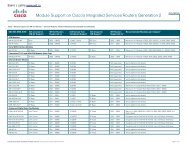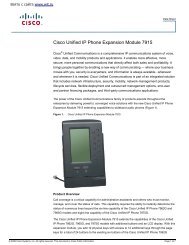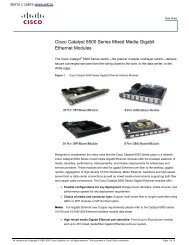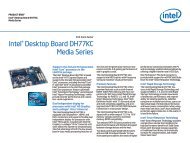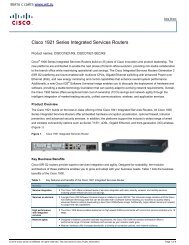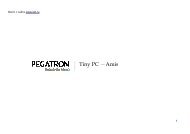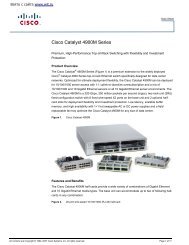CISCO CATALYST 6500 SERIES SUPERVISOR ENGINE 1A AND 2
CISCO CATALYST 6500 SERIES SUPERVISOR ENGINE 1A AND 2
CISCO CATALYST 6500 SERIES SUPERVISOR ENGINE 1A AND 2
Create successful ePaper yourself
Turn your PDF publications into a flip-book with our unique Google optimized e-Paper software.
Взято с сайта www.wit.ruDATA SHEET<strong>CISCO</strong> <strong>CATALYST</strong> <strong>6500</strong> <strong>SERIES</strong><strong>SUPERVISOR</strong> <strong>ENGINE</strong> <strong>1A</strong> <strong>AND</strong> 2As the Cisco ® premier modular multilayer switch, the Cisco Catalyst ® <strong>6500</strong> Series delivers secure, converged servicesfrom the wiring closet to the core, to the data center to the WAN edge.The supervisor engines for the Cisco Catalyst <strong>6500</strong> Series deliver the latest advanced switching technology with proven Cisco software to powera new generation of scalable and intelligent multilayer switching solutions for both enterprise and service provider environments. Designed tointegrate data, voice, and video into a single platform for fully integrated IP communications, the Cisco Catalyst <strong>6500</strong> Series supervisor enginesenable intelligent, resilient, scalable, and secure high performance multilayer switching solutions.The widely deployed Supervisor Engine <strong>1A</strong> and Supervisor Engine 2 are used in wiring closets, distribution/core, data center, and WAN edgeconfigurations enabling the seamless integration of advanced services such as security, voice, and content into a converged network that reducesthe total cost of ownership. And the new Supervisor Engine 720 is ideally suited for high performance core, data center, and metro Ethernetdeployments with its scalable performance of up to 400 million packets per second using a 720 Gbps switch fabric.By sharing a common set of interfaces, operating system and management tools, the Cisco Catalyst <strong>6500</strong> Series supervisors provide operationalconsistency—enabling common sparing and minimizing training requirements; all modules feature predictable performance and a broad rangeof capabilities. Supervisor Engine <strong>1A</strong> and Supervisor Engine 2 highlights include:• Feature-rich and wire-rate intelligent network services—Support and complement comprehensive security and granular quality of servicemechanisms, including identity-based networking capabilities based on IEEE 802.1x extensions and simplified configuration using twoAutoQoS commands• End-to-end flexible deployments—Position anywhere in the network from the wiring closet to the distribution/ core, and from the data centerto the WAN edge and the MAN• Scalable and predictable performance—Feature a flexible switch fabric and forwarding architecture delivering throughput from 15 Mpps/32Gbps (Classic interface modules), to 30 Mpps/256 Gbps (CEF256 interface modules), to 210 Mpps/256 Gbps (dCEF256 interface modules)for network cores supporting multi-gigabit trunks• Flexible multilayer switching support and forwarding architectures—Select basic Layer 2 forwarding or feature-rich Cisco ExpressForwarding (CEF) using the same supervisor• Choice of operating system support—Support both Cisco IOS ® Software, Cisco Catalyst OS software, and Hybrid (Cisco Catalyst OSsoftware and Cisco IOS Software for the MSFC)• Operational consistency—Support all 3 generations of Cisco Catalyst <strong>6500</strong> Series interface and services modules in all Cisco Catalyst <strong>6500</strong>3-, 6-, 9-, and 13-slot chassis running Cisco IOS Software and Cisco Catalyst Operating System Software and a common set of Cisco networkmanagement tools that support the Cisco Catalyst <strong>6500</strong> Supervisor Engine <strong>1A</strong> and 2 as well as many other Cisco Systems ® product lines. (13-slot chassis is compatible with Supervisor Engine 2 only).• Maximum network uptime and user productivity—Provide fault-tolerant network resilience and high availability features including fast 1- to3-second stateful failover between redundant Cisco Catalyst <strong>6500</strong> supervisor engines enabling near-hitless software upgrades for businesscriticalnetwork environments, including IP-telephony enabled wiring closets• Extensive management tools—Support CiscoWorks network management platform, Simple Network Management Protocol (SNMP) versions1, 2, and 3 and four RMON groups (statistics, history, alarms, and events)© 2004 Cisco Systems, Inc. All right reserved.Important notices, privacy statements, and trademarks of Cisco Systems, Inc. can be found on cisco.comPage 1 of 17
As part of the Cisco Catalyst <strong>6500</strong> Series of modular products, Supervisor Engines <strong>1A</strong> and 2 share a common operating system and CLI—encouraging an end-to-end Cisco Catalyst <strong>6500</strong> Series solution for maximum operational consistency, common sparing, and minimized trainingrequirements (Figure 1).Figure 1Supervisor Engines <strong>1A</strong> and Supervisor Engine 2Supervisor Engine 1-PFCSupervisor Engine 2-MSFC2<strong>SUPERVISOR</strong> <strong>ENGINE</strong> <strong>1A</strong> <strong>AND</strong> <strong>SUPERVISOR</strong> <strong>ENGINE</strong> 2 DEPLOYMENT SCENARIOSWith a broad range of interfaces, and services modules, chassis/slot configurations as well as a scalable set of Supervisor Engines, the CiscoCatalyst <strong>6500</strong> can be deployed anywhere in the network. The figure below depicts the Cisco Catalyst <strong>6500</strong> deployed in the wiring closet,distribution, core, data center, WAN edge and Metro and provides recommended supervisor engines for each part of the network.© 2004 Cisco Systems, Inc. All right reserved.Important notices, privacy statements, and trademarks of Cisco Systems, Inc. can be found on cisco.comPage 2 of 17
Figure 2Cisco Supervisor Engine <strong>1A</strong> and Supervisor Engine 2 Deployment ScenariosThe following table outlines the primary deployment scenarios for Cisco Catalyst <strong>6500</strong> Series supervisor engines.Table 1.Deployment Scenarios for Cisco Catalyst <strong>6500</strong> Series Supervisor EnginesSupervisor Engine Performance/Features Recommended DeploymentsSupervisor Engine 720Supervisor Engine 2Policy Feature Card 2(PFC2)Multilayer Switch FeatureCard 2 (MSFC2)Supervisor Engine <strong>1A</strong>PFCMSFC2Supervisor Engine 2 PFC2Supervisor Engine <strong>1A</strong> PFC400 Mpps, 720 Gbps Layer 2–4 distributed Cisco ExpressForwarding Supports new accelerated Cisco ExpressForwarding 720 and distributed Cisco Express Forwarding720 interface modules210 Mpps, 256 GbpsLayer 2–4 distributed Cisco Express ForwardingSupports distributed Cisco Express Forwarding 256interface modules15 Mpps, 32 GbpsCentralized Layer 2–4 forwardingEnhanced security and quality of service (QoS)30 Mpps, 256 Gbps Centralized Layer 2 forwarding andLayer 3–4 services Enhanced security and QoS15 Mpps, 32 GbpsCentralized Layer 2 forwarding and Layer 3–4 servicesEnhanced security and QoSEnterprise core, distribution, and datacentersEnterprise distribution, data centers,and WAN edgeDistribution and corePremium wiring closet and datacenter accessEnterprise wiring closets© 2004 Cisco Systems, Inc. All right reserved.Important notices, privacy statements, and trademarks of Cisco Systems, Inc. can be found on cisco.comPage 3 of 17
Supervisor Engine Performance/Features Recommended DeploymentsSupervisor Engine <strong>1A</strong>2GE15 Mpps, 32 GbpsCentralized Layer 2 forwardingValue wiring closet<strong>SUPERVISOR</strong> <strong>ENGINE</strong> <strong>1A</strong> <strong>AND</strong> 2 FEATURESThe Supervisor Engine <strong>1A</strong> and 2 provide the following features:• High availability• Scalable performance• Wire-rate traffic management• End-to-end management tools• Comprehensive security• Advanced Layer 2, Layer 3, and Layer 4 forwardingHigh AvailabilitySupervisor Engines <strong>1A</strong> and 2 can be deployed in dual-supervisor engine configurations in all Cisco Catalyst <strong>6500</strong> Series chassis (6503, 6506,6509, 6509-NEB, 6509-NEB-A, and 6513 [6513 is compatible with Supervisor Engine 2 only]). The dual-supervisor engine configurationsynchronizes protocol states between the primary and the redundant supervisor engine, provides industry-leading network availability with sub-3-second failover, and maximizes network uptime by allowing hot swapping of standby supervisor engines. Important high-availability featuresinclude:• Supervisor engine redundancy—With synchronization of protocol states and support for HSRP and Uplink Fast• Rapid failover rates—Sub-3-second stateful failover and Layer 3 IP Unicast and Multicast failover• Hot swapping—Hot swapping of standby supervisorsScalable PerformanceSupervisor Engines <strong>1A</strong> and 2 provide scalable performance, from 15 Mpps to 210 Mpps with bandwidth scaling from 32 Gbps to 256 Gbps,that densely populated wiring closets and high-throughput network cores with multigigabit trunks require.Supervisor Engine 2 uses the Cisco Express Forwarding routing architecture that performs high-speed lookups even with advanced Layer 3services enabled, and independent of the number of flows through the switch, while maintaining 30 Mpps of centralized performance and 210Mpps of distributed performance.• Supervisor Engine <strong>1A</strong>—Provides 15-Mpps performance with 32-Gbps bandwidth• Supervisor Engine 2—Provides 30 Mpps of centralized performance and 210 Mpps of distributed performance with 256-Gbps bandwidthFor details see Table 2—Cisco Catalyst <strong>6500</strong> Supervisor Engine Feature Comparison.Wire-Rate Traffic ManagementSupervisor Engines <strong>1A</strong> and 2 provide wire-rate traffic management using Layer 2, 3, and 4 QoS and security checks, including ACL policyenforcement, as part of their forwarding process to protect and secure content. These traffic management features enable efficient handling ofconverged networks that carry a mix of mission-critical, time-sensitive, and bandwidth-intensive multimedia applications.• Advanced QoS tools such as packet classification and marking and congestion avoidance based on Layer 2, Layer 3, and Layer 4 headerinformation.• QoS scheduling rules with thresholds can be configured in the switch for multiple receive and transmit queues.• Rate limiting can be used to police traffic on a per-flow or aggregate basis with a very fine granularity.© 2004 Cisco Systems, Inc. All right reserved.Important notices, privacy statements, and trademarks of Cisco Systems, Inc. can be found on cisco.comPage 4 of 17
For details see Table 3—QoS Features Comparison.End-to-End Management ToolsManaged with CiscoWorks2000, Cisco Catalyst <strong>6500</strong> Series switches can be configured and managed to deliver end-to-end device, VLAN,traffic, and policy management. Cisco Resource Manager, a Web-based management tool that works with CiscoWorks2000, provides:automated inventory collection, software deployment, easy tracking of network changes, views into device availability, and quick isolation oferror conditions.Supervisor Engines <strong>1A</strong> and 2 provide a comprehensive set of management tools to provide the required visibility and control in the network.• Console management—Provide shared interface to the Supervisor Engine 2 and the Multilayer Switch Feature Card 2 (MSFC2) availableout-of-band from a local terminal or remote terminal connected through a modem to the console or auxiliary interface• In-band management—Provide shared interface to the Supervisor Engine 2 and the MSFC2 available in-band through SNMP, Telnet client,Bootstrap Protocol (BOOTP), and Trivial File Transfer Protocol (TFTP)• SPAN—Allow management and monitoring of switch traffic• RSPAN—Allow centralized management and monitoring by aggregating and directing traffic from multiple distributed hosts and switches toa remotely located switch through a trunk link• VACL Capture—Direct traffic to a network analysis port using an ACLFor details see Table 4—Management Tools Comparison.Comprehensive SecurityThe advanced security capabilities of Supervisor Engines <strong>1A</strong> and 2 can reduce the threats of malicious attacks while enabling authentication,authorization, and accounting. With support for up to 32K ACL entries, IP/IPX security ACLs in hardware, and advanced features such as portsecurity, Supervisor Engines <strong>1A</strong> and 2 offer a superior set of Layer 2–4 network traffic security capabilities:• Layer 2 security features—Include private VLANs and port security, to help the network architect properly partition and control theutilization of the switch resources.• Layer 2, 3, and 4 hardware filters—Can work on the forwarding engine and in conjunction with optional integrated services modules toinspect each forwarded packet and permit or deny all the streams of traffic according to the network administrator’s rules.For details see Table 5—PFC and PFC2 Security Features Comparison.<strong>SUPERVISOR</strong> <strong>ENGINE</strong> <strong>1A</strong> <strong>AND</strong> 2 ARCHITECTURECisco Catalyst <strong>6500</strong> Series Supervisor Engines <strong>1A</strong> and 2 manage the system by storing and running the system software, controlling the variousmodules in the chassis, performing basic forwarding, and providing the Gigabit uplinks that allow redundant supervisor engine connections.Supervisor Engine 2 offers an improved forwarding design. The Supervisor Engine <strong>1A</strong> CPU performs Layer 2 forwarding, but SupervisorEngine 2 performs Cisco Express Forwarding (CEF) and distributed CEF, doubling the forwarding performance. As shown in Table 2,Supervisor Engines <strong>1A</strong> and 2 offer choices in operating characteristics, including forwarding architecture, performance, bandwidth, DRAM andboot Flash sizes, and support for chassis, Policy Feature Card/Policy Feature Card 2 (PFC/PFC2), MSFC2, and Switch Fabric Module (SFM).© 2004 Cisco Systems, Inc. All right reserved.Important notices, privacy statements, and trademarks of Cisco Systems, Inc. can be found on cisco.comPage 5 of 17
Table 2.Cisco Catalyst <strong>6500</strong> Supervisor Engine Feature ComparisonFeatureCisco Express Forwarding(CEF)PerformanceSupervisor Engine 2Supervisor Engine-PFC2Supervisor Engine-MSFC2Yes30 Mpps—Supervisor Engine 2-PFC2 andSupervisor Engine 2-MSFC2up to 210 Mpps—Supervisor Engine 2-MSFC2with SFM and DFCsSupervisor Engine <strong>1A</strong>Supervisor Engine <strong>1A</strong>-2GESupervisor Engine <strong>1A</strong>-PFCSupervisor Engine <strong>1A</strong>-MSFCNo15 MppsMaximum bandwidth 256 Gbps (with distributed forwarding) 32 GbpsDRAM 128 MB, 256 MB, 512 MB 128 MBOnboard Flash (BootFlash) 32 MB 16 MBChassis supportedPFC daughter cardavailableMSFC2 daughter cardavailable6006, 6009, 6503, 6506, 6509, 6509-NEB,6509-NEB-A, 65137603, 7606, 7609, OSR-7609, 7613Yes (PFC2); Standard with Supervisor Engine 2Yes, and field upgradable6006, 6009, 6503, 6506, 6509, 6509-NEB,6509-NEB-A7603, 7606, 7609, OSR-7609Yes (PFC); Not field upgradableYes, not field upgradableSFM supported Yes NoThe PFC/PFC2 and MSFC2 daughter cards and the SFM increase Supervisor Engines <strong>1A</strong> and 2 functions:• PFC and PFC2—Perform hardware-based Layer 2, Layer 3, and Layer 4 packet forwarding as well as packet classification, trafficmanagement, and policy enforcement• MSFC2—Performs Layer 3 control plane functions including address resolution and routing protocols• SFM 2—Provides 256 Gbps dedicated bandwidth to all slots in the chassis and requires Supervisor Engine 2-MSFC2. The SFM 2 will notoperate in the same chassis with Supervisor Engine 720.Policy Feature Card (PFC and PFC2)The Policy Feature Card provides quality of service (QoS) and policy based intelligent networking capabilities to the Cisco Catalyst <strong>6500</strong>Series. Recommended for premier wiring closets, backbone, data center and WAN edge deployments, the PFC identifies and classifies trafficapplying the appropriate QoS priority level and Security Policies as defined by the network administrator configured ACLs. The PFC also helpsto prevent unauthorized applications from being allowed on the network.The Supervisor Engine PFC daughter card makes the packet forwarding decision in its application-specific integrated circuit (ASIC) complex.In distributed forwarding implementations, an identical ASIC complex located on an interface module’s DFC daughter card allows the interface© 2004 Cisco Systems, Inc. All right reserved.Important notices, privacy statements, and trademarks of Cisco Systems, Inc. can be found on cisco.comPage 6 of 17
module to make packet-forwarding decisions locally. After the PFC or DFC makes the forwarding decision for the interface module, it sends theforwarding result to the interface module that does all packet buffering, queuing, and delivery.In addition to packet forwarding, the PFC performs the following major functions at wire-rate:• Layer 3 packet classification—Using QoS access-control entries• Traffic management (rate limiting)—Using ingress policing• Security policy enforcement—Within subnets or VLANs• Intelligent multicast forwarding—Efficient replication of multicast streams, supplied to appropriate end-user stations• NetFlow data export—Collecting IP flow statistics for inter-subnet flowsQoSThe following table shows the PFC and PFC2 QoS features.Table 3.QoS Features ComparisonPFC2 PFC No PFCFeatureSupervisor Engine 2-PFC2Supervisor Engine 2-MSFC2Supervisor Engine <strong>1A</strong>-PFCSupervisor Engine <strong>1A</strong>-PFC/MSFC2Supervisor Engine <strong>1A</strong>-2GELayer 2 classification andmarkingLayer 3 classification andmarking/Yes Yes YesYes Yes NoneAccess Control Entries (ACEs) 32K 16KRate limiting location (port) Ingress port, VLAN Ingress port, VLAN NoneRate Limiting Level Types CIR 1 , PIR 2 CIR NoneAggregate traffic rate limiting/ Yes Yes Nonenumber of policers 1023 policers 1023 policersFlow-based rate limitingmethod/ number of rates1 CIR = Committed Information RateFull flow; 64 rates Full flow; 64 rates None2 PIR = Peak Information Rate© 2004 Cisco Systems, Inc. All right reserved.Important notices, privacy statements, and trademarks of Cisco Systems, Inc. can be found on cisco.comPage 7 of 17
Management ToolsThe following table compares the management tools that are available with Supervisor Engines <strong>1A</strong> and 2.Table 4.Management Tools ComparisonFeaturePFCSupervisor Engine <strong>1A</strong>-PFC Supervisor Engine<strong>1A</strong>-PFC/MSFC2 Supervisor Engine 2-PFC2Supervisor Engine 2-MSFC2No PFCSupervisor Engine <strong>1A</strong>-2GESPAN Yes YesRSPAN Yes NoERSPAN No NoVACL Capture Yes NoSecurityTable 5 shows the PFC and PFC2 security features.Table 5.PFC and PFC2 Security Features ComparisonWith PFC2 With PFC Without PFCSupervisor Engine <strong>1A</strong>-PFCFeatureSupervisor Engine 2-PFC2Supervisor Engine 2-MSFC2Supervisor Engine <strong>1A</strong>-PFC/MSFC2Supervisor Engine <strong>1A</strong>-2GEPort security Yes Yes YesTCP intercept hardwareaccelerationIEEE 802.1X and 802.1XextensionsIP security ACLs inhardwareIPX security ACLs inhardwareYes Yes NoYes Yes NoYes Yes NoYes Yes NoSecurity ACL entries 32K 16K NoReflexive ACLs 128K 512K NoUnicast Reverse PathForwarding (uRPF) check-inhardwareYes No NoCPU rate limiters 1 None None© 2004 Cisco Systems, Inc. All right reserved.Important notices, privacy statements, and trademarks of Cisco Systems, Inc. can be found on cisco.comPage 8 of 17
Multilayer Switch Fabric Card2 (MSFC2)Supported on both Supervisor <strong>1A</strong> and Supervisor 2 as an option the MSFC2 acts as the Layer 3 forwarding routing engine. On its Layer 3forwarding routing engine, the MSFC2 builds the CEF Forwarding Information Base (FIB) table in software and then downloads this table tothe ASICs on the PFC or DFC that make the forwarding decisions for IP Unicast and Multicast traffic. For more information see How CiscoExpress Forwarding Works.Layer 3 SwitchingTable 6 shows the MSFC2 Layer 3 switching features.Table 6.Layer 3 Switching Feature ComparisonsMSFC2 No MSFC2 No MSFC2FeatureSupervisor Engine <strong>1A</strong>-PFC/MSFC2 Supervisor Engine 2-MSFC2Supervisor Engine 2-PFC2Supervisor Engine <strong>1A</strong>-2GESupervisor Engine <strong>1A</strong>-PFCIPv4 routing Yes Yes, with MSFC2 upgrade No, not upgradableMPLS Yes, through OSM Yes, through OSM NoIPv6Yes, in software (only on SupervisorEngine 2-MSFC2No, requires MSFC2 upgradeNoRefer to the release notes for up-to-date software version information.SWITCH FABRIC MODULES (SFM <strong>AND</strong> SFM2)Designed to support distributed forwarding, the Cisco Catalyst <strong>6500</strong> Series SFM (WS-X<strong>6500</strong>-SFM) and SFM2 (WS-X<strong>6500</strong>-SFM2) providededicated bandwidth to each slot up to 256 Gbps per system. For distributed forwarding to work, an interface module must have a DistributedForwarding Card (DFC) and must be installed in the chassis with either a Supervisor Engine 2-MSFC2 and an SFM or SFM2, or a SupervisorEngine 720. The SFM works with Cisco Catalyst 6506, 6509, 6509-NEB, and 6509-NEB-A chassis and can occupy any slot. The SFM2 workswith 6506, 6509, 6509-NEB, 6509-NEB-A, 6513, 7603, 7606, 7609, OSR-7609, and 7613 chassis; and it can occupy any slot, except in the6513 and 7613 where it must occupy slot 7 or 8.The Cisco Catalyst 6503 does not currently support the SFM modules as this would leave one slot open after configuring the supervisor andSFM in two of the three available slots. However, the Supervisor 720 provides full CEF256, dCEF256, aCEF720, and dCEF720 capabilities tothe Cisco Catalyst 6503 chassis with its slot-efficient integration of the supervisor engine and switch fabric in a single module.Switch Fabric Module ArchitectureProviding access to the switch fabric through dual 8-Gbps serial channels, the SFM or SFM2 performs all switching on the module ndependentof the passive backplane. For more information see How Distributed Cisco Express Forwarding (dCEF) Works.High AvailabilityTwo SFM and SFM2 modules can be configured in a system for high availability with 1-to-1 redundancy, where one SFM or SFM2 isoperational and one serves as a backup.The SFM and SFM2 cannot operate in the same chassis with a Supervisor Engine 720.© 2004 Cisco Systems, Inc. All right reserved.Important notices, privacy statements, and trademarks of Cisco Systems, Inc. can be found on cisco.comPage 9 of 17
<strong>SUPERVISOR</strong> <strong>ENGINE</strong> 2-MSFC2Suited for deployment in the distribution/core with Classic interface modules, CEF256 interface modules and dCEF256 interface modules,Supervisor <strong>1A</strong>-2GE provides Layer 2/3/4 forwarding with the following operational advantages:• Layer 2–4 forwarding—Performs Layer 2–4 forwarding with Layer 2, 3, 4 features; supports dCEF256 interface modules• Media Access Control (MAC) addresses—128K• Forwarding rate—Up to 30 Mpps per system• Bandwidth—32 Gbps per system; 256 Gbps with SFM in chassis• Layer 2, 3 traffic classification and marking—Layer 2 and Layer 3 (See Table 3—QoS Features Comparison for details)• Multilayer (Layer 3) switching—IPv4 supported (See Table 6 for details)• Distributed forwarding—Requires Switch Fabric Module and interface modules with Distributed Forwarding Cards (DFCs); for details, seesection titled How Distributed Cisco Express Forwarding (dCEF) Works• Operating system—Cisco Catalyst OS with Cisco IOS on the MSFC and Cisco IOS Software• Management tools—SPAN, RSPAN, VACL capture• DRAM—128, 256, 512 MB• Onboard flash (BootFlash)—32 MB• Chassis supported—Cisco Catalyst 6006, 6009, 6503, 6506, 6509, 6509-NEB, 6509-NEB-A, and 6513; 7603, 7606, 7609, OSR-7609, and7613• Slot requirements—Slots 1 or 2 of any chassis• Upgrade support—None requiredFigure 3Cisco Catalyst <strong>6500</strong> Series Supervisor Engine 2-MSFC2<strong>SUPERVISOR</strong> <strong>ENGINE</strong> 2-PFC2Suited for deployment in wiring closets with Classic and CEF256 interface modules, Supervisor Engine 2-PFC2 provides basic Layer 2forwarding with the following operational advantages:• Layer 2 forwarding—Performs Layer 2 forwarding with Layer 2, 3, 4 features; requires MSFC2 upgrade to support Layer 3, 4 forwarding• MAC addresses—128K• Forwarding rate—Up to 30 Mpps per system• Bandwidth—32 Gbps per system; 256 Gbps with SFM in chassis• Layer 2, 3 traffic classification and marking—Layer 2 and Layer 3 (See Table 3—QoS Features Comparison for details)• Multilayer (Layer 3) switching—Requires MSFC2 upgrade (See Table 6 for details)© 2004 Cisco Systems, Inc. All right reserved.Important notices, privacy statements, and trademarks of Cisco Systems, Inc. can be found on cisco.comPage 10 of 17
• Distributed forwarding—Requires MSFC2 upgrade, SFM, and interface modules with DFCs (for details, see section titled How DistributedCisco Express Forwarding Works).• Operating system—Cisco Catalyst OS only (Cisco IOS Software supported with MSFC2 upgrade)• Management tools—SPAN, RSPAN, VACL capture• DRAM—128, 256, 512 MB• Onboard flash (BootFlash)—32 MB• Chassis supported—Cisco Catalyst 6006, 6009, 6503, 6506, 6509, 6509-NEB, 6509-NEB-A, and 6513; 7603, 7606, 7609, OSR-7609, and7613• Slot requirements—Slots 1 or 2 of any chassis• Upgrade support—MSFC2 upgrade<strong>SUPERVISOR</strong> <strong>ENGINE</strong> <strong>1A</strong>-PFC/MSFC2Suited for deployment in the distribution/core with Classic interface modules, Supervisor Engine <strong>1A</strong>-2GE provides Layer 2–4 forwarding withthe following operational advantages:• Layer 2–4 forwarding—Performs Layer 2–4 forwarding with Layer 2–4 features• MAC addresses—128K• Forwarding rate—Up to 15 Mpps per system• Bandwidth—32 Gbps per system• Layer 2, 3 traffic classification and marking—Layer 2 and Layer 3 (see Table 3—QoS Features Comparison for details)• Multilayer (Layer 3) switching—IPv4 supported (See Table 6 for details)• Distributed forwarding—Unsupported• Operating system—Cisco Catalyst OS with Cisco IOS on the MSFC and Cisco IOS Software• Management tools—SPAN, RSPAN, VACL capture• DRAM—128 MB• Onboard flash (BootFlash)—16 MB• Chassis supported—Cisco Catalyst 6006, 6009, 6503, 6506, 6509, and 6509-NEB, 6509-NEB-A (6513 not supported); 7603, 7606, 7609,and OSR-7609 (7613 not supported)• Slot requirements—Slots 1 or 2 of any chassis• Upgrade support—NoneFigure 4Cisco Catalyst <strong>6500</strong> Supervisor Engine <strong>1A</strong>-PFC/MSFC2© 2004 Cisco Systems, Inc. All right reserved.Important notices, privacy statements, and trademarks of Cisco Systems, Inc. can be found on cisco.comPage 11 of 17
<strong>SUPERVISOR</strong> <strong>ENGINE</strong> <strong>1A</strong>-PFCSuited for deployment in wiring closets with Classic interface modules, Supervisor Engine <strong>1A</strong>-2GE provides basic Layer 2 forwarding with thefollowing operational advantages:• Layer 2 forwarding—Performs basic Layer 2 forwarding with no Layer 2–4 features• MAC addresses—128K• Forwarding rate—Up to 15 Mpps per system• Bandwidth—32 Gbps per system• Layer 2, 3 traffic classification and marking—Layer 2 and Layer 3 (See Table 3—QoS Features Comparison for details)• Multilayer (Layer 3) switching—Unsupported• Distributed forwarding—Unsupported• Operating system—Cisco Catalyst OS only• Management tools—SPAN, RSPAN, VACL capture• DRAM—128 MB• Onboard flash (BootFlash)—16 MB• Chassis supported—Cisco Catalyst 6006, 6009, 6503, 6506, 6509, and 6509-NEB, 6509-NEB-A (6513 not supported); 7603, 7606, 7609,and OSR-7609 (7613 not supported)• Slot requirements—Slots 1 or 2 of any chassis• Upgrades—NoneFigure 5Cisco Catalyst <strong>6500</strong> Supervisor Engine <strong>1A</strong>-PFC<strong>SUPERVISOR</strong> <strong>ENGINE</strong> <strong>1A</strong>-2GESuited for deployment in wiring closets with Classic interface modules, Supervisor Engine <strong>1A</strong>-2GE provides basic Layer 2 forwarding with thefollowing operational advantages:• Layer 2 forwarding—Performs Layer 2 forwarding with Layer 4 features• MAC addresses—128K• Forwarding rate—Up to 15 Mpps per system• Bandwidth—32 Gbps per system• Layer 2, 3 traffic classification and marking—Layer 2 only, not upgradable to support Layer 3 (for details, see Table 3—QoS FeaturesComparison)• Multilayer (Layer 3) switching—Unsupported© 2004 Cisco Systems, Inc. All right reserved.Important notices, privacy statements, and trademarks of Cisco Systems, Inc. can be found on cisco.comPage 12 of 17
• Distributed forwarding—Unsupported• Operating system—Cisco Catalyst OS only• Management tools—SPAN only• DRAM—128 MB• Onboard flash (BootFlash)—16 MB• Chassis supported—Cisco Catalyst 6006, 6009, 6503, 6506, 6509, and 6509-NEB, 6509-NEB-A (6513 not supported); 7603, 7606, 7609,and OSR-7609 (7613 not supported)• Slot requirements—Slots 1 or 2 of any chassis• Upgrade support—NoneHOW <strong>CISCO</strong> EXPRESS FORWARDING WORKSCisco Express Forwarding (CEF) is a Layer 3 technology that provides increased forwarding scalability and performance to handle many shortdurationtraffic flows common in today’s enterprise and service provider networks. To meet the needs of environments handling large amountsof short-flow, Web-based, or highly interactive types of traffic, CEF forwards all packets in hardware, and maintains its forwarding ratecompletely independent of the number of flows going through the switch.On the Cisco Catalyst <strong>6500</strong> Series, the CEF Layer 3 forwarding engine is located centrally on the supervisor engine’s PFC2 or PFC3—the samedevice that performs hardware-based Layer 2 and 3 forwarding, ACL checking, QoS policing and marking, and NetFlow statistics gathering.Using the routing table that Cisco IOS Software builds to define configured interfaces and routing protocols, the CEF architecture creates CEFtables and downloads them into the hardware-forwarding engine before any user traffic is sent through the switch. The CEF architecture placesonly the routing prefixes in its CEF tables—the only information it requires to make the Layer 3 forwarding decisions—relying on the routingprotocols to do route selection. By performing a simple CEF table lookup, the switch forwards packets at wire-rate, independent of the numberof flows transiting the switch.CEF-based forwarding requirements: Requires a Cisco Catalyst Supervisor Engine 2 or Cisco Catalyst Supervisor Engine 720.HOW DISTRIBUTED <strong>CISCO</strong> EXPRESS FORWARDING WORKSWith Distributed Cisco Express Forwarding (dCEF), forwarding engines located on the interface modules make forwarding decisions locallyand in parallel, allowing the Cisco Catalyst <strong>6500</strong> Series to achieve the highest forwarding rates in the industry. With dCEF, forwarding occurson the interface modules in parallel and system performance scales up to 400 Mpps—the aggregate of all forwarding engines working together.Using the same ASIC engine design as the central PFCx, DFCs located on the interface modules forward packets between two ports, directly oracross the switch fabric, without involving the supervisor engine. With the DFC, each interface module has a dedicated forwarding enginecomplete with the full forwarding tables. dCEF forwarding works like this:• As in standard CEF forwarding, the central PFC3 located on the supervisor engine and the DFC engines located on the interface modules areloaded with the same CEF information derived from the forwarding table before any user traffic arrives at the switch.• As a packet arrives at an interface module, its DFC engine inspects the packet and uses the information in the CEF table (including Layer 2,Layer 3, ACLs, and QoS) to make a completely hardware-based forwarding decision for that packet.• The dCEF engine handles all hardware-based forwarding for traffic on that module, including Layer 2 and Layer 3 forwarding, ACLs, QoSpolicing and marking, and NetFlow.• Because the DFCs make all the switching decisions locally, the supervisor engine is freed from all forwarding responsibilities and canperform other software-based functions, including routing, management, and network services.© 2004 Cisco Systems, Inc. All right reserved.Important notices, privacy statements, and trademarks of Cisco Systems, Inc. can be found on cisco.comPage 13 of 17
Figure 6Distributed Cisco Express Forwarding Packet FlowdCEF-based forwarding requirements: Requires a Cisco Catalyst Supervisor Engine 720 for dCEF720 interface modules; requires either aCisco Catalyst Supervisor Engine 720 or a Cisco Catalyst Supervisor Engine 2-MSFC2 and a SFM for dCEF256 interface modules.SOFTWARE REQUIREMENTSDepending on its configuration, a supervisor engine will operate with one or more of the following operating systems:• Cisco IOS Software for the supervisor engine (native Cisco IOS Software)• Cisco Catalyst OS software• Hybrid, Cisco Catalyst OS software and Cisco IOS Software for the MSFC Notes: Refer to the release notes for up-to-date software versioninformation.© 2004 Cisco Systems, Inc. All right reserved.Important notices, privacy statements, and trademarks of Cisco Systems, Inc. can be found on cisco.comPage 14 of 17
ORDERING INFORMATIONTable 7 lists the ordering information for the Supervisor Engines <strong>1A</strong> and 2.Table 7.Product Numbers for OrderingProduct NumberWS-X6K-SUP<strong>1A</strong>-2GEWS-X6K-SUP<strong>1A</strong>-PFCWS-X6K-S<strong>1A</strong>-MSFC2WS-X6K-S2-PFC2WS-X6K-S2-MSFC2WS-X6K-S2U-MSFC2WS-X6K-S<strong>1A</strong>-MSFC2WS-X6K-S<strong>1A</strong>-MSFC2=WS-X6K-S<strong>1A</strong>-MSFC2/2DescriptionCisco Catalyst <strong>6500</strong> Supervisor Engine<strong>1A</strong>, 2GECisco Catalyst <strong>6500</strong> Supervisor Engine<strong>1A</strong>, 2GE, plus PFCCisco Catalyst <strong>6500</strong> Supervisor Engine<strong>1A</strong>, 2GE, plus MSFC-2 and PFCCisco Catalyst <strong>6500</strong> Supervisor Engine 2, 2GE, plus PFC-2Cisco Catalyst <strong>6500</strong> Supervisor Engine 2, 2GE, plus MSFC-2/PFC-2Cisco Catalyst <strong>6500</strong> Supervisor Engine2, 2GE, plus MSFC-2/PFC-2 with 512MB for MSFC-2Supervisor Engine <strong>1A</strong> with PFC+MSFC2Supervisor Engine <strong>1A</strong> with PFC+MSFC2=Supervisor Engine <strong>1A</strong> with PFC+MSFC2/2WS-F6K-MSFC2 Cisco Catalyst <strong>6500</strong> Multilayer Switch Feature Card 2MEM-MSFC2-128MB=MEM-MSFC2-256MBMEM-MSFC2-256MB=MEM-MSFC2-512MBMEM-MSFC2-512MB=WS-X<strong>6500</strong>-SFMCisco Catalyst <strong>6500</strong> MSFC2 Memory, 128 MB DRAM SpareCisco Catalyst <strong>6500</strong> MSFC2 Memory, 256 MB DRAM OptionCisco Catalyst <strong>6500</strong> MSFC2 Memory, 256 MB DRAM SpareCisco Catalyst <strong>6500</strong> MSFC2 Memory, 512 MB DRAM OptionCisco Catalyst <strong>6500</strong> MSFC2 Memory, 512 MB DRAM SpareCisco Catalyst <strong>6500</strong> Switch Fabric ModuleWS-X<strong>6500</strong>-SFM2 Cisco Catalyst <strong>6500</strong> Switch Fabric Module 2Dimensions• (H x W x D): 1.6 x 15.3 x 16.3 in. (4.0 x 37.9 x 40.3 cm)Environmental Conditions• Operating temperature: 32 to 104°F (0 to 40°C)• Storage temperature: –40 to 167°F (–40 to 75°C)• Relative humidity: 10 to 90%, noncondensing• Regulatory complianceSafety Certifications• UL 1950• EN 60950© 2004 Cisco Systems, Inc. All right reserved.Important notices, privacy statements, and trademarks of Cisco Systems, Inc. can be found on cisco.comPage 15 of 17
• CSA-0C22.2 No. 950• IEC 950Electromagnetic Emissions Certifications• FCC 15J Class A• VCCI CE II• CE mark• EN 55022 Class B• CISPR 22 Class BTechnical Support ServicesWhether your company is a large organization, a commercial business, or a service provider, Cisco Systems is committed to maximizing thereturn on your network investment. Cisco offers a portfolio of Technical Support Services to ensure that your Cisco products operate efficiently,remain highly available, and benefit from the most up-to-date system software.Cisco Technical Support Services offers the following features, which help enable network investment protection and minimal downtime forsystems running mission-critical applications:• Provides Cisco networking expertise online and on the telephone• Creates a proactive support environment with software updates and upgrades as an ongoing integral part of your network operations, notmerely a remedy when a failure or problem occurs• Makes Cisco technical knowledge and resources available to you on demand• Augments the resources of your operations technical staff to increase productivity• Complements remote technical support with onsite hardware replacement• The Cisco portfolio of Technical Support Services includes:• Cisco SMARTnet support• Cisco SMARTnet Onsite support• Cisco Software Application Services, including Software Application Support and Software Application Support plus Upgrades For moreinformation visit:http://www.cisco.com/en/US/products/svcs/ps3034/serv_category_home.htmlAdditional Cisco Catalyst <strong>6500</strong> Series InformationFor additional information about the Cisco Catalyst <strong>6500</strong> Series, supervisor engines, interface modules, SFM, and services modules, visit:http://www.cisco.com/en/US/products/hw/switches/ps708/products_data_sheets_list.html• Cisco Catalyst <strong>6500</strong> Series Data Sheet• Cisco Catalyst <strong>6500</strong> Supervisor Engine 720 Data Sheet• Cisco Catalyst 10/100 and 10/100/1000 Ethernet Data Sheet• Cisco Catalyst <strong>6500</strong> Gigabit Ethernet Interface Modules Data Sheet• Cisco Catalyst <strong>6500</strong> 10 Gigabit Ethernet Interface Modules Data Sheet• Cisco Catalyst <strong>6500</strong> FlexWAN Interface Modules Data Sheet• Cisco Catalyst <strong>6500</strong> Switch Fabric Interface Modules Data Sheet• Cisco Catalyst <strong>6500</strong> Content Services Module (CSM) Data Sheet• Cisco Catalyst <strong>6500</strong> Firewall Services Module Data Sheet• Cisco Catalyst <strong>6500</strong> Network Application Module (NAM) Data Sheet• Cisco Catalyst <strong>6500</strong> Intrusion Detection (IDS) Module Data Sheet• Cisco Catalyst <strong>6500</strong> IP Sec/VPN Services Module Data Sheet© 2004 Cisco Systems, Inc. All right reserved.Important notices, privacy statements, and trademarks of Cisco Systems, Inc. can be found on cisco.comPage 16 of 17
• Cisco Catalyst <strong>6500</strong> SSL Services Module Data SheetCorporate HeadquartersCisco Systems, Inc.170 West Tasman DriveSan Jose, CA 95134-1706USAwww.cisco.comTel: 408 526-4000800 553-NETS (6387)Fax: 408 526-4100European HeadquartersCisco Systems InternationalBVHaarlerbergparkHaarlerbergweg 13-191101 CH AmsterdamThe Netherlandswww-europe.cisco.comTel: 31 0 20 357 1000Fax: 31 0 20 357 1100Americas HeadquartersCisco Systems, Inc.170 West Tasman DriveSan Jose, CA 95134-1706USAwww.cisco.comTel: 408 526-7660Fax: 408 527-0883Asia Pacific HeadquartersCisco Systems, Inc.168 Robinson Road#28-01 Capital TowerSingapore 068912www.cisco.comTel: +65 6317 7777Fax: +65 6317 7799Cisco Systems has more than 200 offices in the following countries and regions. Addresses, phone numbers, and fax numbers are listed onthe Cisco Web site at www.cisco.com/go/offices.Argentina • Australia • Austria • Belgium • Brazil • Bulgaria • Canada • Chile • China PRC • Colombia • Costa Rica • Croatia • CyprusCzech Republic • Denmark • Dubai, UAE • Finland • France • Germany • Greece • Hong Kong SAR • Hungary • India • Indonesia • IrelandIsrael • Italy • Japan • Korea • Luxembourg • Malaysia • Mexico • The Netherlands • New Zealand • Norway • Peru • Philippines • PolandPortugal • Puerto Rico • Romania • Russia • Saudi Arabia • Scotland • Singapore • Slovakia • Slovenia • South Africa • Spain • SwedenSwitzerland • Taiwan • Thailand • Turkey • Ukraine • United Kingdom • United States • Venezuela • Vietnam • ZimbabweCopyright 2004 Cisco Systems, Inc. All rights reserved. CCIP, CCSP, the Cisco Powered Network mark, Cisco Unity, Follow Me Browsing, FormShare, and StackWise aretrademarks of Cisco Systems, Inc.; Changing the Way We Work, Live, Play, and Learn, and iQuick Study are service marks of Cisco Systems, Inc.; and Aironet, ASIST, BPX,Catalyst, CCDA, CCDP, CCIE, CCNA, CCNP, Cisco, the Cisco Certified Internetwork Expert logo, Cisco IOS, the Cisco IOS logo, Cisco Press, Cisco Systems, Cisco SystemsCapital, the Cisco Systems logo, Empowering the Internet Generation, Enterprise/Solver, EtherChannel, EtherSwitch, Fast Step, GigaStack, Internet Quotient, IOS, IP/TV, iQExpertise, the iQ logo, iQ Net Readiness Scorecard, LightStream, Linksys, MGX, MICA, the Networkers logo, Networking Academy, Network Registrar, Packet, PIX, Post-Routing, Pre-Routing, RateMUX, Registrar, ScriptShare, SlideCast, SMARTnet, StrataView Plus, Stratm, SwitchProbe, TeleRouter, The Fastest Way to Increase Your InternetQuotient, TransPath, and VCO are registered trademarks of Cisco Systems, Inc. and/or its affiliates in the United States and certain other countries.© 2004 Cisco Systems, Inc. All right reserved.All other trademarks mentioned in this document or Web site are the property of their respective owners. The use of the word partner does not imply a partnership relationshipbetween Cisco and any otherImportantcompany.notices,(0402R)privacy statements, and trademarks of Cisco Systems, Inc.ETMGcan204064—ECbe found06.04on cisco.comPage 17 of 17Printed in the USA
© 2004 Cisco Systems, Inc. All right reserved.Important notices, privacy statements, and trademarks of Cisco Systems, Inc. can be found on cisco.comPage 18 of 17



